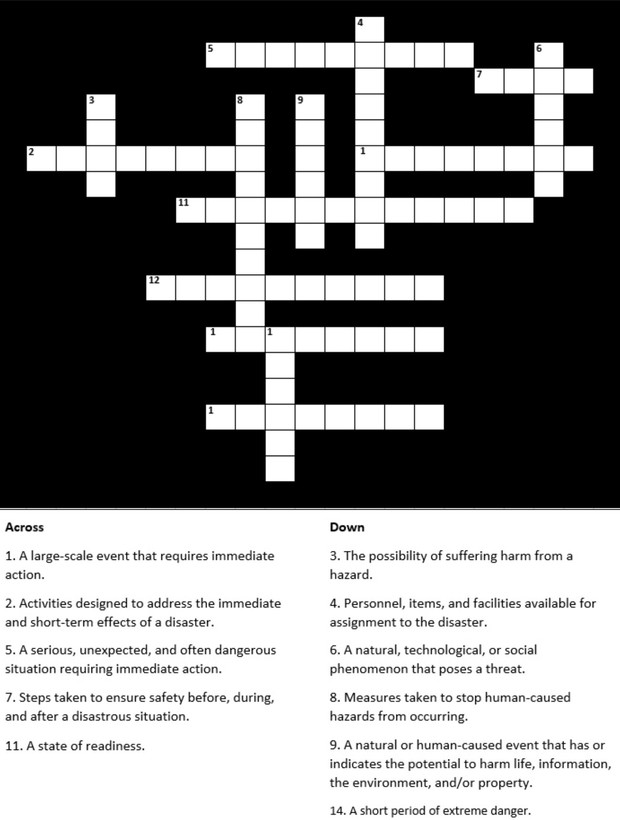|
Hurricane Sally reponse and recovery operations post-landfall in Septemebr 2020. Image: Department of Homeland Security
2020 has certainly tested us all with a wide and deep array of real-life events for us to address, respond to, and learn from. Learn about how the National Ocean Service’s Disaster Preparedness Program (DPP) rose to the challenge with this recap of some of the successes that the DPP and our partners accomplished during the trying conditions of fiscal year 2020.
Emergency Support Functions. Image: Department of Homeland Security
When a catastrophic disaster strikes, it can overwhelm local and state governments to the point they cannot provide all of the necessary resources. During these disasters, the federal government steps in to provide help—through response support, the use of federal programs, resources, and supplies. Click here to learn more about the Emergency Support Functions that provide the structure most frequently used to provide Federal support for declared disasters and emergencies under the Stafford Act as well as for non-Stafford Act incidents.
Infrastructure damage from a magnitude 7.0 earthquake in Anchorage, Alaska in 2018. Image credit: USGS
When it comes to earthquakes, what should we be prepared for, or concerned about? Is it really the magnitude of the earthquake that poses the greatest threat, or does infrastructure, proximity to water, or expectation (high risk areas) play a larger factor? The answer is not a definitive one, but the Disaster Preparedness Program believes we can learn from others in this regard. Click here to learn about the importance of earthquake preparedness and how you can be ready for any disaster.
Bird strike prevention film added to all of the NOAA Gulf of Mexico Disaster Response Center windows. Image: NOAA
The NOAA Gulf of Mexico Disaster Response Center (DRC), operated by the Disaster Preparedness Program, is a multi-purpose facility located in Mobile, Alabama, which serves NOAA and our partners to enhance preparedness for and support response to all hazards. Established in 2012, the center is strategically equipped to support preparedness, response, and recovery efforts.
In 2020, the facility was put to good use when hurricanes Sally and Zeta impacted the Alabama coast. While the center didn’t sustain any damage, there were still needed improvements to ensure the facility continues to provide comfort, safety and functionality to occupants while also being environmentally and energy friendly. Click here to learn more about the many improvements to the DRC.
NOAA Navigation Response Team vessel and autonomous surface vehicle. Image: NOAA
The Disaster Preparedness Program is excited to announce the recipients of the second annual Preparedness Lagniappe Awards. Funds were made available to National Ocean Service (NOS) program offices to fill preparedness gaps or innovate their current preparedness efforts.
In the second year of the annual award cycle, grants were awarded to the Office for Coastal Management and Office of Coast Survey. Four projects were selected for funding including: ensuring communications and safety for NOS staff on remote islands; developing Next Generation Disaster Resilient Plans for National Estuarine Research Reserves; designing and installing disaster resilient environmental monitoring platform for coastal estuaries; and upgrades to NOAA’s Echoboat 160. Click here to learn more about the four projects that were selected for funding.
Being prepared for winter weather is critical. Image: NOAA
Winters are notorious for impacting those who underestimate seasonal hazards or fail to prepare. Fortunately, the Disaster Preparedness Program reminds us that we can typically foresee and prepare for the risks associated with winter weather. Check out these winter preparedness measures that will ensure the safety of your home, vehicle, and physical and behavioral health during the coldest months.
ESI shoreline type: sheltered tidal flats. Image: Research Planning Inc.
In December 2020, NOAA’s Office of Response and Restoration hosted a workshop focused on defining what the next generation of Environmental Sensitivity Index (ESI) maps should look like. ESI maps provide a concise summary of coastal resources that are at risk if an oil spill occurs nearby. Examples of at-risk resources include biological resources (such as birds and shellfish beds), sensitive shorelines (such as marshes and tidal flats), and human-use resources (such as public beaches and parks).
All workshop participants agreed that ESI maps remain an integral part of emergency response planning, preparedness, response, and assessment efforts, and should be maintained. Workshop participants identified critical data layers, scale, necessary distribution formats, and potential areas of collaboration, as well as weighed the pros and cons of various development approaches. Several working groups will be established this year to continue the work of refining necessary data layers, data structure, and format for the next generation of ESI maps.
Image: U.S. Bureau of Labor Statistics
Are you experiencing disaster fatigue or remote work burnout? You're not alone. Check out this Disaster Preparedness Program blog for important tips on how to combat disaster fatigue and remote work burnout, especially after a year that included a record-breaking hurricane season, extensive wildfires, civil unrest, and a global pandemic.

|